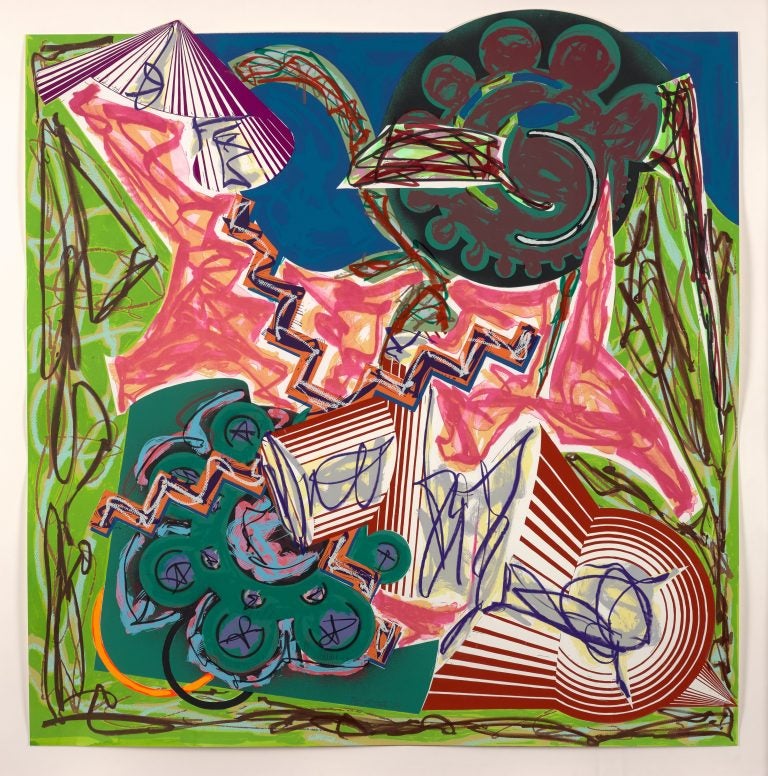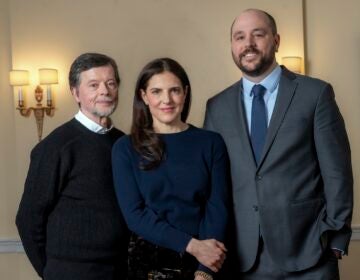Princeton alum Frank Stella, ‘god of the ’60s art world,’ honored with exhibit
These 41 prints on display at the Princeton Art Museum demonstrate how the master abstractionist pioneered innovations in printmaking.

"Then Came an Ox and Drank the Water," 1984. Hand-coloring and collage with lithograph, linocut, and screenprint on T.H. Saunders paper (background) and shaped, hand-cut Somerset paper (collage), 137.2 × 133 cm. Collection of Preston H. Haskell, Class of 1960. (© 2017 Frank Stella / Artists Rights Society (ARS), New York)
When Frank Stella’s children were young, he took them to Brooklyn’s Coney Island aquarium to see the whales. Fascinated, the family went home where Papa read aloud from “Moby Dick.” Thus began the artist’s fascination with Herman Melville’s tale of the great white whale.
To honor Stella 60 years after his graduation from Princeton University, the Princeton Art Museum is exhibiting Frank Stella Unbound: Literature and Printmaking through Sept. 23. The exhibition focuses on four series of prints, each based on a literary work, made between 1984 and 1999: the Passover song “Had Gadya”; a compilation of Italian folktales; the illustrated Dictionary of Imaginary Places; and “Moby Dick.”
These 41 prints demonstrate how the master abstractionist pioneered innovations in printmaking.
Born in 1936, Stella grew up in a Massachusetts household in which both parents liked to paint. At Princeton, he took classes in studio art but majored in art history, completing his senior thesis on medieval Irish, Carolingian and Ottonian art. The Daily Princetonian, in reviewing Stella’s shows, made a note to “keep an eye on this guy, he’s going places,” according to Mitra Abbaspour, curator of modern and contemporary art. Later that same year, Stella moved to New York and began “The Black Paintings” that launched his career and exerted a formative influence on minimalist sculpture.
Within 12 years of his Princeton graduation, Stella was well on his way with a midcareer retrospective at the Whitney Museum.
The New Yorker’s Peter Schjeldahl has called Stella “a god of the sixties art world… His impact on abstract art was something like Dylan’s on music and Warhol’s on more or less everything.”
For the print series in Stella Unbound, the artist worked with master printer Ken Tyler. Wanting to challenge the medium, Tyler had collaborated with such artists at Josef Albers, Jasper Johns and Robert Rauschenberg. Stella had previously thought of printmaking as a way to reproduce artwork, not as artwork in and of itself. Working with Tyler, he began to weave his painting and sculpture into printmaking.
An introductory essay to the catalog for Stella Unbound by exhibition curators Abbaspour and Calvin Brown points out that Stella does not illustrate the texts; rather, he finds rhythms and organizational structures, transforming the narrative properties to a visual vocabulary of gesture and geometric forms.
The “Moby Dick” prints grew from Rockwell Kent’s (1882-1971) series of graphic, black-and-white woodcut prints to illustrate a deluxe edition of the novel. Between 1989 and 1993, Stella created more than 266 individual works — paintings, sculptures and prints — all titled after the 135 chapters of the epic novel.
“It was the magnum opus of his career,” said Abbaspour. “He worked on the “Moby Dick” series for 12 years, starting with maquettes based on the whale wave form.”
Stella evolved the compositions for the richly complex prints he made in response by creating collages that he cut, tore and layered together from myriad sources — including excerpts drawn from his extensive archive of printed proofs, computer renderings, industrial printing plates and found images reproduced from old pattern books. Translated by Stella’s studio collaborators at Tyler Graphics into combinations of mixed techniques, the Imaginary Places prints utilize nearly every reproductive process known to the history of Western art.
“He wants to reinvigorate abstraction with these four cycles of prints,” said Brown. “Tyler and Stella worked together in a way that spurred their creative energy. They dared each other to do bigger and more elaborate things. Tyler was a printmaking innovator who engineered processes and invented presses” such as a concave press for making convex prints.
“It’s insane,” said Brown of the amount of thought and innovation that goes into the process. There are patterns from benday dots from enlargements to orange construction fencing and even a digitized image of cigar smoke. “It’s, like, nuts.”
Stella and Tyler’s relationship was deeply collaborative. Brown compares Stella to the composer; Tyler, the conductor; and the printmaking team (about eight or nine members), the orchestra. “Stella thinks of sound, and the conductor assigns it to the orchestra.”
WHYY is your source for fact-based, in-depth journalism and information. As a nonprofit organization, we rely on financial support from readers like you. Please give today.





